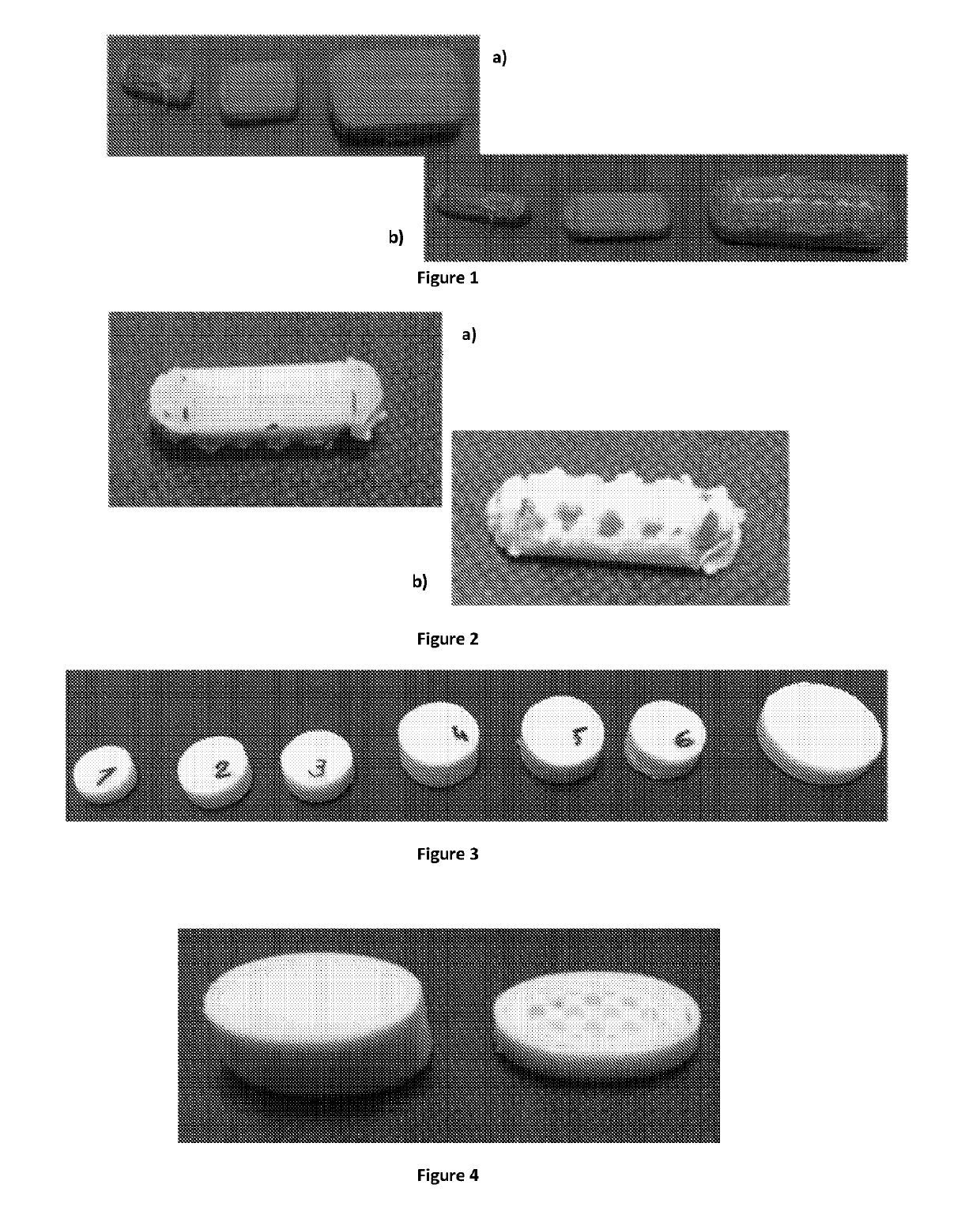Solid dosage form production
- Summary
- Abstract
- Description
- Claims
- Application Information
AI Technical Summary
Benefits of technology
Problems solved by technology
Method used
Image
Examples
example 1
ting the Printing of Designs of a Tablet Using Commercially Available Dissolvable PVA Filament
1.1 Materials and Equipment
[0465]Prednisolone was purchased from (Severn Biotech Ltd, UK). Polyvinyl alcohol (PVA) filaments (melting point; 160-170° C., specific heat; 0.4 Cal / g° C., Density; 1.25-1.35 g / cm3) were purchased from Reprapcentral (UK). Glycerol, acetonitrile and methanol was supplied by British Drug Houses (BDH) (London, UK). Castor Oil was purchased from Sigma-Aldrich (St. Louis, USA). Oleic acid was obtained from VWR (Radnor, USA). Scotch blue painter's tape 5 mm was supplied by 3M (Bracknell, UK).
[0466]MakerBot Replicator® 2X Experimental 3D Printer (MakerBot Industries, LLC, New York, USA) was utilized to print blank PVA tablets (i.e. tablets without any active).
[0467]Blank tablets (PVA only) were printed using default settings of the software for PLA filament as follows: type of printer: Replicator 2X; type of filament: PLA; resolution: standard; temperature of nozzle: 23...
example 2
f Drug Dose in the 3D Printed Tablet and Physical and In Vitro Characterization of the Product
2.1 Outline of Study
[0487]In this Example, the inventors examined the ability of the 3D printer to control the drug loading (i.e. the dose) of a tablet by controlling the volume of the printed solid dosage form. Furthermore, the inventors assessed drug loading levels within the tablets formed, as well as the accuracy of drug dosing.
[0488]In general, the same materials and equipment was used as those set forth in Example 1, albeit with modifications as described below.
2.2 Experiment 2A—Modification of 3D Printer
[0489]Before printing prednisolone loaded PVA tablets, the following modifications were implemented:
[0490]a) The default Kapton tape layer provided poor adhesion to the designs to the build platform. As such, this tape was replaced by blue Scotch painters tape applied to the surface of the build platform to improve adhesion to the surface layer.
[0491]b) Drug-loaded PVA filaments were ...
example 3
nt of Pharmaceutical Grade Filament for 3D Printing
[0534]A wide variety of experiments were performed in the development and optimisation of pharmaceutical grade filaments. The following experiments elucidated some of the principle considerations in the preparation of pharmaceutical grade filaments and solid dosage forms printed therefrom. The elucidation of these principle considerations contributes a wealth of knowledge which the skilled person may use to develop a wide range of pharmaceutical formulations with various drugs, excipients, and release profiles. For instance, the ensuing experiments enable the preparation of solid dosage forms with immediate, extended and delayed release properties.
3.1 Experiment 3A—Preparation of Filaments
[0535]Active ingredient-containing printing filaments (those which do contain an active, which in these examples is generally a drug) and further printing filaments (which do not necessarily contain an active), were prepared via a hotmelt extrusion...
PUM
| Property | Measurement | Unit |
|---|---|---|
| Temperature | aaaaa | aaaaa |
| Temperature | aaaaa | aaaaa |
| Temperature | aaaaa | aaaaa |
Abstract
Description
Claims
Application Information
 Login to View More
Login to View More - Generate Ideas
- Intellectual Property
- Life Sciences
- Materials
- Tech Scout
- Unparalleled Data Quality
- Higher Quality Content
- 60% Fewer Hallucinations
Browse by: Latest US Patents, China's latest patents, Technical Efficacy Thesaurus, Application Domain, Technology Topic, Popular Technical Reports.
© 2025 PatSnap. All rights reserved.Legal|Privacy policy|Modern Slavery Act Transparency Statement|Sitemap|About US| Contact US: help@patsnap.com



